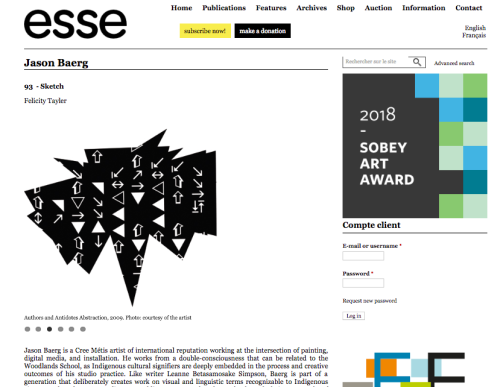I had the pleasure of writing this profile of Jason Baerg for issue 93 of esse arts+opinions Sketch/Esquisse

Jason Baerg is a Cree Métis artist of international reputation working at the intersection of painting, digital media, and installation. He works from a double-consciousness that can be related to the Woodlands School, as Indigenous cultural signifiers are deeply embedded in the process and creative outcomes of his studio practice. Like writer Leanne Betasamosake Simpson, Baerg is part of a generation that deliberately creates work on visual and linguistic terms recognizable to Indigenous viewers and readers. Non-Indigenous publics are attracted to the works through their own uptake of worldviews that are coded within the visual forms. Woodlands stands as a multigenerational reference for visual artists who have worked in this manner. Norval Morrisseau, Daphne Odjig, Alex Janvier, and their peers adopted the so-called universalism of modernist abstraction as a vocabulary within which they could express an internal landscape of spiritual, cultural, and political affirmation.
In Baerg’s work a transcultural double-coding takes place as tensions arise between figuration and abstraction, and across physical and digital media. This play across representational and intermedial registers can be seen in two bodies of work: Relations (2010/2018) and Authors and Antidotes(2009). Relations reinvents the Western avant-garde’s break with verisimilitude in portraiture, by looking to Indigenous traditions of abstraction that predate modernism in Eurocentric art-historical timelines. The pairing of oil painting with digital sketches and animations inserts a sense of futurity into this redrawn timeline. Authors and Antidotes combines large-scale, hard-edge abstraction with collage-like strategies reminiscent of concrete poetry and combine paintings. The ASCII character code, which unifies the eclectic visual field, is a transposition of Baerg’s reflective writing practice. While this text addresses personal and community healing, these themes are also echoed in the red, yellow, white, and black colour fields, which correspond to the traditional Cree teachings of the four directions. On one hand the ASCII code can be read through a shared subculture of nostalgia for early computer technologies; on the other, this code and its palette camouflage meanings recognizable to viewers with lived experience of Indigenous traditional knowledge and practices.
For the full article and images: http://esse.ca/en/jason-baerg